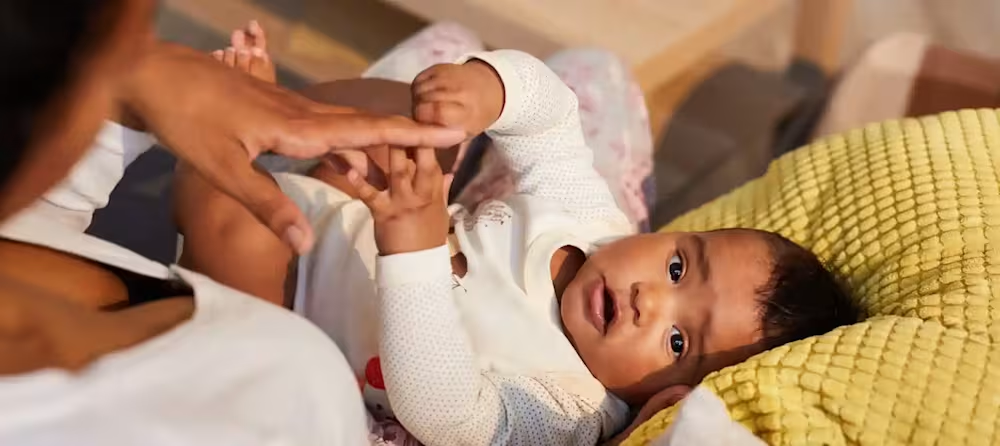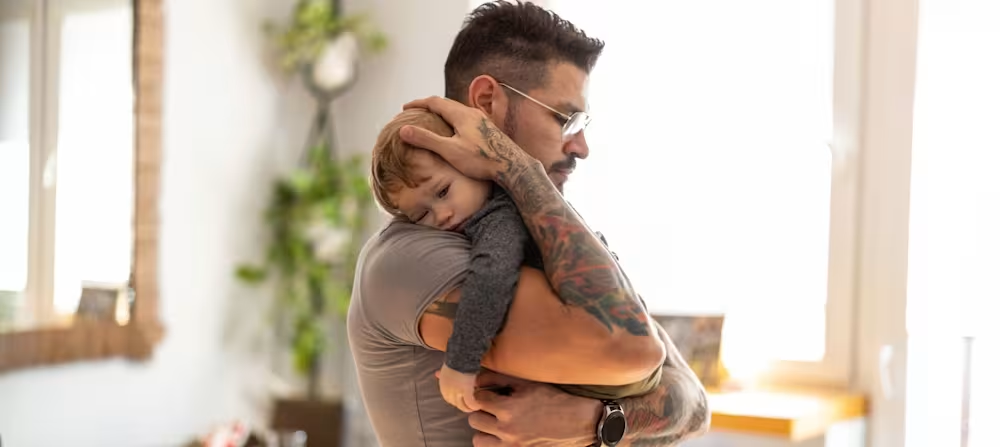Is it OK for a baby to sleep on their stomach?
Updated Oct 16, 2025

During the first year, babies spend plenty of time eating, tackling adorable milestones, and, of course — sleeping. Adjusting to an infant’s sleeping habits certainly comes with challenges (hello, ), which may tempt you to let them sleep however they are most comfortable. But can newborns be placed to sleep on their tummy? What about infants?
In short, babies should always be placed on their backs to sleep for the first 12 months []. In this article, we will discuss when babies can sleep on their stomachs, along with the risks of tummy sleeping and how to encourage your little one to stay snoozing on their back.
Table of Contents
When can babies sleep on their stomachs? Signs they are ready
It's best to always lay babies on their backs for naps and nighttime sleep until they turn one year old. But don't worry — if your little one rolls over to their side or tummy by themselves, and they can roll both ways, it's okay to leave them be.
Note that there are a very small number of babies that have specific medical needs that require them to sleep on their stomachs, though. If you're unsure, your baby’s doctor can guide you on what’s best for your little one.
Safe sleep guidelines
By practicing safe sleep guidelines from the American Academy of Pediatrics (AAP), you can help keep your little one safe. These include:
Always put your baby to sleep on their back on a firm, flat sleep surface (i.e., a crib or bassinet).
Never let your baby (under 1 year) sleep with loose blankets, toys, stuffed animals, bumper pads, pillows, quilts, comforters, mattress toppers, non-fitted sheets, or any products that could increase the risk of suffocation.
Don’t use any weighted sleep products, including weighted sleepers, swaddles, or blankets.
Keep an eye out for signs of overheating, such as sweating, a hot chest, or flushed skin.
Share a room with your baby for at least the first six months — it can decrease the risk of SIDS by as much as 50 percent.
Offer a pacifier at nap and bedtime, as it is associated with a decreased risk of SIDS [].
The importance of tummy time
Once your little one is able to roll both ways, stomach sleeping becomes much safer. The best way to help them learn is through plenty of tummy time!
By 2 months old, babies should be getting around 15 to 30 minutes of supervised tummy time each day. [] Spending time on their belly helps build core, neck, shoulder, and arm strength, all of which they need to roll, sit up, crawl, and eventually walk. Tummy time also plays a key role in developing your baby’s motor skills and can help prevent flat spots on their head from sleeping on their back.
Some babies simply don’t like being on their tummies, and that’s normal! To help make it a little more enjoyable, try placing a book or toy in front of them, laying them tummy-to-tummy or across your lap, and limiting tummy time sessions to just a few minutes, spread throughout the day. It’s also best to avoid tummy time if your baby is tired or fussy. (Right after a nap works best!)
Reasons babies shouldn’t be placed on their stomachs to sleep
To ensure the safety of your little one (and peace of mind for you!), babies under 1 year of age should always be placed on their backs to sleep. A baby sleeping on their stomach has a higher risk of the following:
Sudden Infant Death Syndrome (SIDS): SIDS — also known as sudden unexpected infant death (SUID) — refers to the unexplained death of a baby less than a year old. The AAP explains that SIDS may be linked to a baby’s inability to wake up. [] Placing babies on their backs to sleep can help prevent this and lower the risk of SIDS.
Risk of suffocation: When a baby sleeps on their belly, they inhale the air they already breathed out, which can lead to too much carbon dioxide and too little oxygen in their body [] — increasing the risk of suffocation. On the other hand, a baby sleeping on their back is able to get the oxygen they need without breathing in expired air.
Overheating: A baby sleeping on their belly can get hot, which is a problem when they are unable to switch positions. Research also has found that babies who get too hot are at a greater risk of SIDS. [] A supine position (lying facing upward) has been associated with lower body temperature in babies.
Choking: When a baby sleeps on their stomach, the tube that leads to their stomach sits above the one leading to their lungs. Due to gravity (from being on their stomach), this causes any fluids coming up from the stomach to gather at the entrance of the lung tube, which can increase the likelihood of choking.
What to do if baby rolls onto stomach while sleeping
If your baby can consistently roll both ways (back to tummy and tummy to back), the AAP says it’s okay to leave them on their stomach if they roll over during sleep. Once your baby can roll (or shows signs they are close), you should as a safety precaution.
If the rolling milestone is still a work in progress, you may notice your child gets frustrated when they roll onto their tummy and can’t roll back. Try giving them a few minutes before intervening to see if they can work it out on their own. If not, gently reposition them to their back. (This is a good opportunity to let them try to fall back asleep on their own if you’re comfortable with that!)
You can also have your baby practice rolling for short periods in the place where they sleep. This helps them get used to seeing the sleep space from all different angles, so they won't be as startled when they wake up and it looks different from when they went to sleep.
If you are concerned your baby is not meeting developmental milestones like rolling, your baby’s medical provider is there to help. It’s important to reach out with any questions or concerns and keep up with routine well-child visits.
If you’re struggling with sleep as your little one learns to master rolling, ! By pairing pediatric sleep experts with AI, we’re able to provide a custom, step-by-step sleep plan to help your child get the rest they need.
What should I do if my baby refuses to sleep on their back?
If your infant loves to doze off while cuddled against your chest, you’re not alone! It’s natural for infants to prefer sleeping while being held. Luckily, there are options that can allow you to gradually transition them to back sleeping.
Try the transport response: According to research, the “transport response” may help a tired, fussy baby get to sleep. [] The steps are fairly simple: Walk while holding your baby for five minutes, then sit with them for at least eight minutes. You can then gently transition them to their sleep space — on their back. The study found this particular amount of time is ideal for babies to be put down in their sleep space without waking up.
Keep them upright for reflux: If your child struggles with reflux, try holding them upright for 30 minutes after feeding before laying them down. This can help relieve gas and discomfort.
Try gentle sleep training methods: You can start in their crib with gentle techniques. “Sleep training” or “sleep shaping” can help ease your little one into falling asleep in their crib and doesn’t require you to leave the room or let your baby cry for long periods.
Talking to caregivers about safe sleep
If you plan to have other caregivers take care of your child (such as grandparents, friends, babysitters, or daycare providers), it’s important to ensure everyone is on the same page about safe sleep practices. Many people (especially those who raised kids in previous generations) were taught to put babies to sleep on their stomachs before the Back to Sleep campaign started in the early 1990s. As a result, they might not be aware of the updated guidelines and the risks associated with the older practices. []
By talking with other caregivers about , along with AAP safe sleep guidelines, you can ensure your little one remains in a safe sleep environment whenever you’re not around.
Takeaway
For the first 12 months, babies should always be placed on their backs to sleep.
Once a baby is able to roll both ways (tummy to back and back to tummy), it’s okay to leave them on their stomach if they roll that way in their sleep. If they can only roll one way or not at all, gently return them to their back if they roll onto their tummy.
Follow safe sleep guidelines: Put your baby on their back on a firm, flat sleep surface (such as a crib or bassinet) that is free of blankets, stuffed animals, bumper pads, pillows, or anything else that may increase the risk of suffocation. Watch for signs of overheating, including sweating or a hot chest, and share a room for at least the first six months.
To help your baby stay snoozing, you can try a swaddle (as long as they haven’t shown signs of rolling), offer a pacifier, play , and avoid dressing them in too many layers.
If your little one prefers being held for sleep and you’d like to get them used to their sleep space, try the transport response: walk while holding your baby for at least five minutes, then sit with them for at least 8 minutes before moving them to a crib or bassinet.
Always reach out to your child’s doctor if you have any concerns about their growth and development.
Baby sleeping on stomach FAQ
Share article:
Note: The content on this site is for informational purposes only and should not replace medical advice from your doctor, pediatrician, or medical professional. If you have questions or concerns, you should contact a medical professional.
8 Sources
Table of Contents
Share article:








